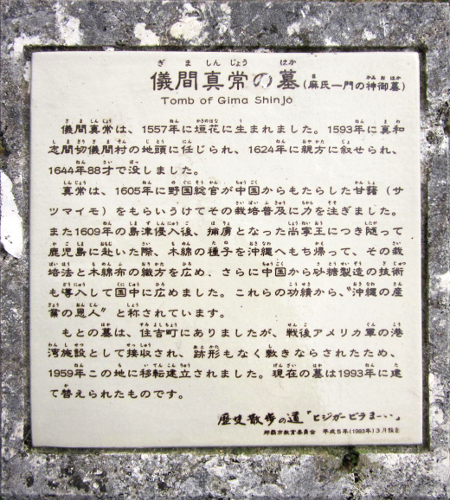Names and DOB
- Childhood name: Shinshi 眞市
- Chinese-style name: Ma Heikō 麻平衡
- Born: as the thirdborn son, 1557.
Family
- Father: Shinmei 眞命
- Mother: Manabi 眞鍋 of the Sō-clan 莊氏
- Wife: Manabi 眞鍋, daughter of Ahagon Shī Sei’i 阿波根子盛懿 of the Mō-clan 毛氏 (she died 1633-06-09. Posthumous name: Rinshun 林春)
- Oldest son: Shinshi 眞之
- Oldest daughter: Maushi 眞牛 (date of birth and death unknown, married Goeku Niya 越來爾也)
Chronology
During the Era of King Shō Gen 尚元王
- During the Longqing years (1567–1572): Served as Ko-akukabe 小赤頭
During the Era of King Shō Ei 尚永王
- During the reign of the Wanli emperor (1572–1620): served as squire (Hana-atari 花當), conferred to the court rank of Waka-satonushi (若里之子), conferred to a Yellow Hachimaki (黄冠), i.e. he was promoted to Pēchin status.
During the Era of King Shō Nei 尚寧王
- 1593-05-06: Assuming the family headship from his father, he is appointed Estate steward (Jitō 地頭) of Gima in Mawashi district 眞和志儀間地頭
- 1596-06-05: Served as commander (Seitō) of the Oshiaketomi 押明富勢頭
- 1605, Noguni Sōkan 野國總管 brought sweet potatoes plants from Fujian, China. When Shinjō 眞常 heard about his, he asked to study potato cultivation. Noguni explained to him: “To cultivate [the potato], fold it into a strip of hemp cloth of about 30cm length and place it in the field. When the time has come, pull up the cloth strip and so pull out the potato from the hole.” By planting potatoes in the whole country, supplementing the five crops, Gima Shinjō 眞常 planned to counteract food shortages and huge famines, which happened frequently. For 15 years Gima Shinjō instructed the cultivation of potatoes in Ryūkyū. Additionally, he was also active in the cultivation of various other crops and grains.
- 1606-08-11: Appointed Seitō of the Jakunitomi (castle guard commander) 謝國富勢頭
- 1609-04: When King Sho Nei 尚寧王 was taken to Satsuma (Sasshū 薩州), Gima Shinjō accompanied him in the role of a guard (Seitō) (勢頭役). The ship set sails in Naha on 1609-05-17. He returned to Ryūkyū on 1611-09-13. On 1611-12-01 he was conferred to the court rank of Zashiki (rank 4 minor) 座敷. From Satsuma, Gima Shinjō had brought back cotton seeds for weaving cotton cloths. Gima Shinjō told two Japanese women (named Umechiyo 梅千代 and Michiyo 實千代) who lived in Izumisaki village to begin to manufacture cloth by weaving, and this was the beginning of cotton cloth weaving in Ryūkyū.
- Although in olden times this country had its own sugar cane, it was unknown how to manufacture brown sugar. Consequently, in 1623, at the time when the tribute ship sailed to Fujian, Gima Shinjō ordered some villagers of Gima to accompany the tribute ship and to study the method of sugar refinement. First this method of sugar refinement was done at Gima Shinjō’s house, and later spread in the whole country.
- Gima Shinjō was also appointed Magistrate of Farmland (Tenchi Bugyō 田地奉行 )
During the Era of King Shō Hō 尚豊王
- 1624-01-15: Conferred to the court rank of purple Hachimaki 紫冠, i.e. the rank of Uēkata
- 1624-05-04: In this country [of Ryūkyū], since ancient times until now dragon boat races have been performed as magnificent spectacles. So, Gima Shinjō 眞常 was requested to make preparations in connection with dragon boat races. In this connection, his Majesty the King Shō Hō 尚豊 honored Gima Shinjō with his presence at the latter’s residence.
- 1627-06-22: Receives a fief income of 30 Koku
- 1644-10-14: Died after a long life of 88 years. Posthumous name: Juryō 授了
Additional Info
Although Gima Shinjō was only the thirdborn son, he succeeded the head of household.
He passed through a typical career within the government organization of old Ryūkyū. This included positions in the HIKI (see here for a short overview).
Starting as an apprentice (Ko-akukabe 小赤頭), at around 40 he became commander (Seitō) of the Oshiaketomi regiment. Around 50 years of age, he was appointed commander of the castle guards (Seitō of the Jakunitomi).
Not surprisingly, when a few years later – in 1609 – the Shimazu Clan conquered the Ryūkyū Kingdom and took King Sho Nei to Satsuma, Gima Shinjō accompanied him in the role of a guard (Seitō).
Actually, there is the tradition of the Bo of Gima Shinjo.
Sources
- 沖縄の歴史情報 第5巻。画像と全文テキストデータベース (Ⅰ)。 (6)「琉球家譜」の情報化。①首里系家譜。麻姓家譜 (田名家).
- Naha-shi Shi. Shiryō-hen, Dai Ni Maki, Chū no 7. Naha no Minzoku. 那覇市史。資料篇 第2巻,中の7。那覇の民俗。
- others

Placque at Gima Shinjo’ tomb, located at the Hijigaabira-maai.
© 2017 – 2022, Andreas Quast. All rights reserved.
